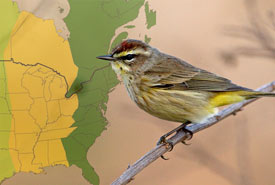Ohhhhh Canada, Viva Virginia…This is Florida calling!

Palm warbler (Collage by One Sky Our Birds)
I have some exciting news from Florida: I am starting to see flocks of wood-warblers in our coastal hammocks on the Great Florida Birding and Wildlife Trail. They have just completed an epic journey from the tropics, where they spent the winter months, and are feeding voraciously on insects and fruit, borne by the native trees in our coastal hammocks and forests. Florida bird watchers like myself will be reveling in the beauty of these tiny birds, perhaps the most popular family of species in North America.
Coastal habitat is critical for these species, as it is the first habitat these tired, hungry birds reach after crossing the Caribbean Sea and Gulf of Mexico. While in Florida, they will build up their energy levels so they can complete the next leg of their incredible migration to the northern forests of Canada, where they will nest and raise their young.
Some of the wood-warblers migrating to Canada through Florida return to the same areas year after year. Banding studies show species like black-throated blue warblers, palm warblers and ovenbirds visit Cape Florida on Key Biscayne for several successive years. One particular ovenbird has returned to Key Biscayne from its northern breeding grounds for seven straight years! In spring and fall, Bill Baggs State Park on Key Biscayne is a vitally important stopover site for songbirds such as the palm warbler.
Palm warblers winter in South Florida, the Caribbean and South America. In April, they migrate north to raise their families in the forests of Canada and New England. Once nesting is complete, they head south again, arriving at their winter homes between September and November. This incredible journey can be more than 4,000 miles long and takes several weeks to complete!
To enjoy these remarkable little birds during migration, visit the following Great Florida Birding and Wildlife Trail sites:
- Dry Tortugas National Park
- Bill Baggs State Park
- Fort De Soto Park
- Cedar Key
- George Island State Park
- Fort Pickens
What you can do to help our migratory birds
There are many different ways in which you can help birds complete their amazing migration:
- Use native plants in your backyard landscaping, OR, learn which plants provide appropriate foods and cover for migratory birds and use them in your home landscaping;
- Provide a consistent source of clean water;
- Submit your bird sightings to eBird;
- Volunteer to remove invasive wildlife species harmful to migratory birds;
- Help prevent window strikes;
- Buy shade-grown, bird friendly coffee; learn more at Smithsonian Migratory Bird Center's site;
- Purchase a wildlife management area permit to help support fish and wildlife conservation on Florida’s public lands;
- Purchase a Federal Duck Stamp;
- Support conservation of lands along the flyway. Work with other interested citizens to encourage the protection of unique tracts of land not currently protected that provide vital migratory bird habitat.
Keep scanning the trees — the palm warbler is heading north! One Sky Our Birds!
This blog is reposted with permission from One Sky Our Bird's blog.


